Rare Metal (Li–Ta–Nb) Mineralization and Age of the Kvartsevoye Pegmatite Deposit (Eastern Kazakhstan)
Abstract
1. Introduction
2. Geological Background
3. Methods
4. Results
4.1. Lithology
4.1.1. Granites
4.1.2. Pegmatites of the Main Body
4.2. Mineralogy
4.3. Geochemistry
4.4. Ar/Ar Age
5. Discussion
6. Conclusions
Author Contributions
Funding
Data Availability Statement
Acknowledgments
Conflicts of Interest
References
- Balaram, V.; Santosh, M.; Satyanarayanan, M.; Srinivas, N.; Gupta, H. Lithium: A review of applications, occurrence, exploration, extraction, recycling, analysis, and environmental impact. Geosci. Front. 2024, 15, 101868. [Google Scholar] [CrossRef]
- Ma, J.; Guo, X.; Xue, H.; Pan, K.; Liu, C.; Pang, H. Niobium/tantalum-based materials: Synthesis and applications in electrochemical energy storage. Chem. Eng. J. 2020, 380, 122428. [Google Scholar] [CrossRef]
- Wei, X.; Xia, L.; Liu, Z.; Zhang, L.; Li, Q. A review of tantalum resources and its production. Trans. Nonfer. Met. Soc. China 2023, 33, 3132–3156. [Google Scholar] [CrossRef]
- Vikentiev, I.V. Critical and Strategic Minerals in the Russian Federation. Geol. Ore Depos. 2023, 65, 481–493. [Google Scholar] [CrossRef]
- Cerny, P. Rare-element granitic pegmatites. Part I: Anatomy and internal evolution of pegmatite deposits. Geosci. Can. 1991, 18, 49–67. [Google Scholar]
- London, D. Ore-forming processes within granitic pegmatites. Ore Geol. Rev. 2018, 101, 349–383. [Google Scholar] [CrossRef]
- Khromykh, S.V.; Oitseva, T.A.; Kotler, P.D.; D’yachkov, B.A.; Smirnov, S.Z.; Travin, A.V.; Vladimirov, A.G.; Sokolova, E.N.; Kuzmina, O.N.; Mizernaya, M.A.; et al. Rare-Metal Pegmatite Deposits of the Kalba Region, Eastern Kazakhstan: Age, Composition and Petrogenetic Implications. Minerals 2020, 10, 1017. [Google Scholar] [CrossRef]
- Oitseva, T.A.; Dyachkov, B.A.; Bissatova, A.Y.; Orazbekova, G.B.; Zinyakin, S.S. Features of formation, material composition and geological structure of rare metal and pegmatite deposits of the Kalba region on the example of the Yubileinoye deposit. Bull. Tomsk. Polytech. Univ. Geo Assets Eng. 2023, 334, 164–176. [Google Scholar] [CrossRef]
- Pushko, E.P. Report on the Results of Exploration Work in North-Western Kalba for 1965–69; Technical Report; Vostkazgeologiya Production Geological Association: Ust-Kamenogorsk, Kazakhstan, 1971. (In Russian) [Google Scholar]
- Ermolin, V.T.; Pushko, E.P.; Rybalchenko, N.G.; Yaroshenko, O.N. Report of the Irtysh GRP on the Results of Exploration Work in the North-Western Kalba for 1965–1969 (Areas: Kvartsevoye, Aktyube, Bekkuduk, Izmailovsky, Kovalevsky, Nikolaevsky, Sotchigiz, Aktobe); Technical Report; Vostkazgeologiya Production Geological Association: Ust-Kamenogorsk, Kazakhstan, 1971. (In Russian) [Google Scholar]
- Ganzha, E.A.; Rybina, L.P.; Kucherova, V.T. Report with Calculation of Reserves for the Quartz Deposit (as of 01.07.1972); Technical Report; Vostkazgeologiya Production Geological Association: Ust-Kamenogorsk, Kazakhstan, 1972. (In Russian) [Google Scholar]
- D’yachkov, B.A.; Mizernaya, M.A.; Khromykh, S.V.; Bissatova, A.Y.; Oitseva, T.A.; Miroshnikova, A.P.; Frolova, O.V.; Kuzmina, O.N.; Zimanovskaya, N.A.; Pyatkova, A.P.; et al. Geological History of the Great Altai: Implications for Mineral Exploration. Minerals 2022, 12, 744. [Google Scholar] [CrossRef]
- Khromykh, S.V. Basic and associated granitoid magmatism and geodynamic evolution of the Altai accretion–collision system (Eastern Kazakhstan). Russ. Geol. Geophys. 2022, 63, 279–299. [Google Scholar] [CrossRef]
- Kotler, P.D.; Khromykh, S.V.; Kruk, N.N.; Sun, M.; Li, P.; Khubanov, V.B.; Semenova, D.V.; Vladimirov, A. Granitoids of the Kalba batholith, Eastern Kazakhstan: U–Pb zircon age, petrogenesis and tectonic implications. Lithos 2021, 188–389, 106056. [Google Scholar] [CrossRef]
- Tischendorf, G.; Gottesmann, B.; Forster, H.-J.; Trumbull, R. On Li-bearing micas: Estimating Li from electron microprobe analyses and an improved diagram for graphical representation. Mineral. Mag. 1997, 61, 809–834. [Google Scholar] [CrossRef]
- Breiter, K.; Galiová, M.V.; Korbelová, Z.; Hložková, M. Can lithium contents in mica be correctly calculated? Tischendorf’s proposal (Mineralogical Magazine 61/1997) 25 years after. Mineral. Mag. 2023, 6, 878–886. [Google Scholar] [CrossRef]
- Baksi, A.K.; Archibald, D.A.; Farrar, E. Intercalibration of 40Ar–39Ar dating standards. Chem. Geol. 1996, 129, 307–324. [Google Scholar] [CrossRef]
- Travin, A.V.; Yudin, D.S.; Vladimirov, A.G.; Khromykh, S.V.; Volkova, N.I.; Mekhonoshin, A.S.; Kolotilina, T.B. Thermochronology of the Chernorud granulite zone, Ol’khon Region, Western Baikal area. Geochem. Inter. 2009, 47, 1107–1124. [Google Scholar] [CrossRef]
- Tischendorf, G.; Forster, H.-J.; Gottesmann, B. Minor- and trace-element composition of trioctahedral micas: A review. Mineral. Mag. 2001, 65, 249–276. [Google Scholar] [CrossRef]
- Cerny, P.; Ercit, S. The classification of granitic pegmatites revisited. Can. Mineral. 2005, 43, 2005–2026. [Google Scholar] [CrossRef]
- Smirnov, S.Z. The fluid regime of crystallization of water-saturated granitic and pegmatitic magmas: A physicochemical analysis. Russ. Geol. Geophys. 2015, 56, 1292–1307. [Google Scholar] [CrossRef]
- Dittrich, T.; Seifert, T.; Schulz, B.; Hagemann, S.; Gerdes, A.; Pfänder, J. Archean Rare-Metal Pegmatites in Zimbabwe and Western Australia; Springer Briefs in World Mineral Deposits; Springer: Cham, Switzerland, 2019; 125p. [Google Scholar]
- Zimanovskaya, N.A.; Oitseva, T.A.; Khromykh, S.V.; Travin, A.V.; Bissatova, A.Y.; Annikova, I.Y.; Aitbayeva, S.S. Geology, Mineralogy, and Age of Li-Bearing Pegmatites: Case Study of Tochka Deposit (East Kazakhstan). Minerals 2022, 12, 1478. [Google Scholar] [CrossRef]
- Shen, P.; Pan, H.; Li, C.; Feng, H.; He, L.; Bai, Y.; Luo, Y.Q.; Suo, Q.Y.; Cao, C. Newly-recognized Triassic highly fractionated leucogranite in the Koktokay deposit (Altai, China): Raremetal fertility and connection with the No. 3 pegmatite. Gondwana Res. 2022, 112, 24–51. [Google Scholar] [CrossRef]
- Fanka, A.; Tadthai, J. Petrology and geochemistry of Li-bearing pegmatites and related granitic rocks in southern Thailand: Implications for petrogenesis and lithium potential in Thailand. Front. Earth Sci. 2023, 11, 1221485. [Google Scholar] [CrossRef]
- Zhang, L.; Jiang, S.-Y.; Romer, R.L.; Zhang, H.-X.; Wan, S.-L. Characteristics and formation of rare-metal pegmatites and granites in the Duanfengshan-Guanyuan district of the northern Mufushan granite complex in South China. Lithos 2024, 474–475, 107579. [Google Scholar] [CrossRef]
- Zagorsky, V.Y.; Vladimirov, A.G.; Makagon, V.M.; Kuznetsova, L.G.; Smirnov, S.Z.; D’yachkov, B.A.; Annikova, I.Y.; Shokalsky, S.P.; Uvarov, A.N. Large fields of spodumene pegmatites in the settings of rifting and postcollisional shear–pull-apart dislocations of continental lithosphere. Rus. Geol. Geoph. 2014, 55, 237–251. [Google Scholar] [CrossRef]
- Kotler, P.D.; Khromykh, S.V.; Vladimirov, A.G.; Travin, A.V.; Kruk, N.N.; Murzintsev, N.G.; Navozov, O.V.; Karavaeva, G.S. New data on the age and geodynamic interpretation of the Kalba-Narym granitic batholith, Eastern Kazakhstan. Dokl. Earth Sci. 2015, 462, 565–569. [Google Scholar] [CrossRef]
- Manning, D.A.C. The effect of fluorine on liquidus phase relationships in the system Qz-Ab-Or with excess water at 1 kb. Contr. Mineral. Petrol. 1981, 76, 206–215. [Google Scholar] [CrossRef]
- Pichavant, M.; Villaros, A.; Deveaud, S.; Scaillet, B.; Lahlafi, M. The influence of redox state on mica crystallization in leucogranitic and pegmatitic liquids. Can. Mineral. 2016, 54, 559–581. [Google Scholar] [CrossRef]
- Pichavant, M.; Erdmann, S.; Kontak, D.J.; Michaud, J.A.S.; Villaros, A. Trace element partitioning in strongly peraluminous rare-metal silicic magmas—Implications for fractionation processes and for the origin of the Macusani Volcanics (SE Peru). Geochim. Cosmochim. Acta 2024, 365, 229–252. [Google Scholar] [CrossRef]


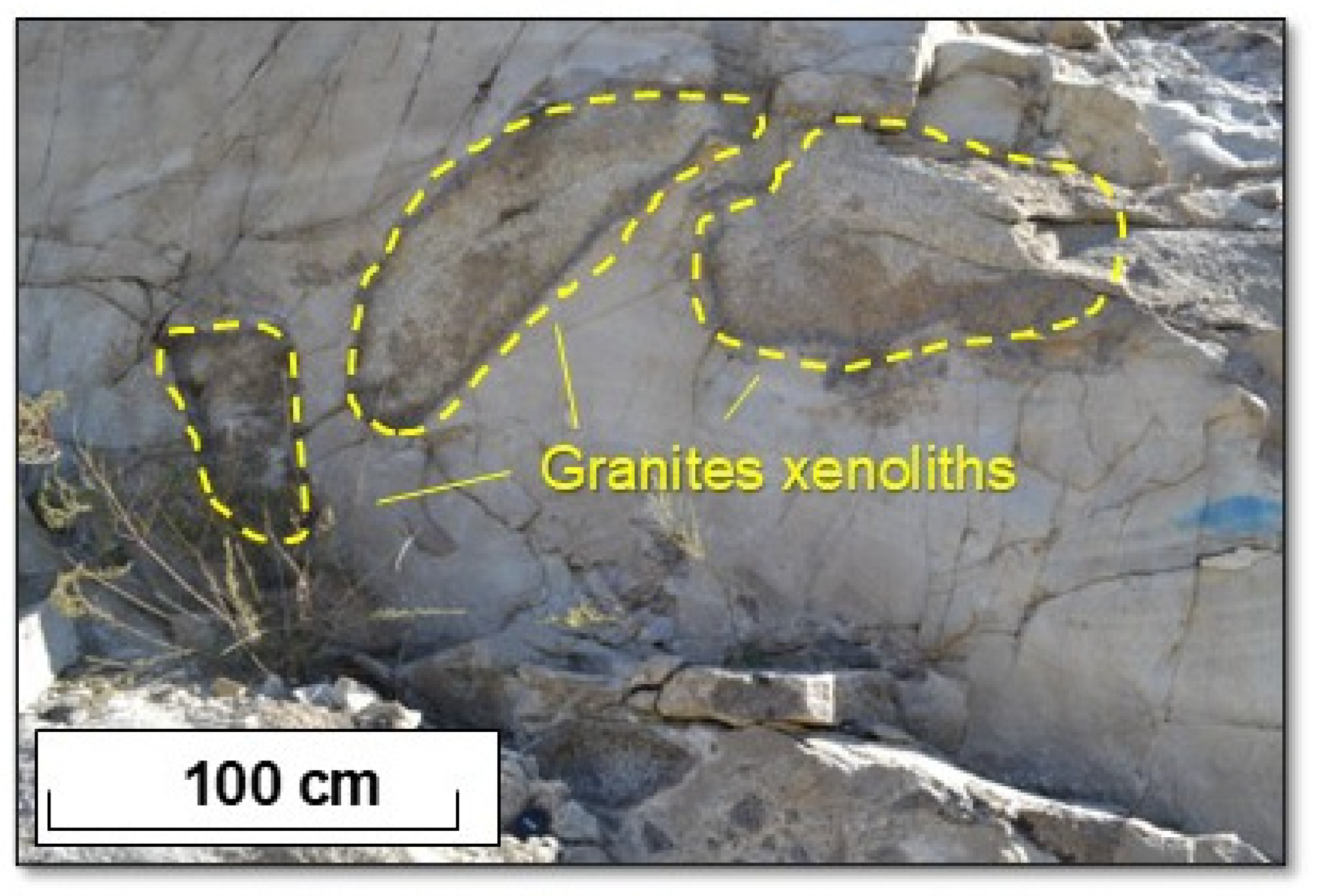
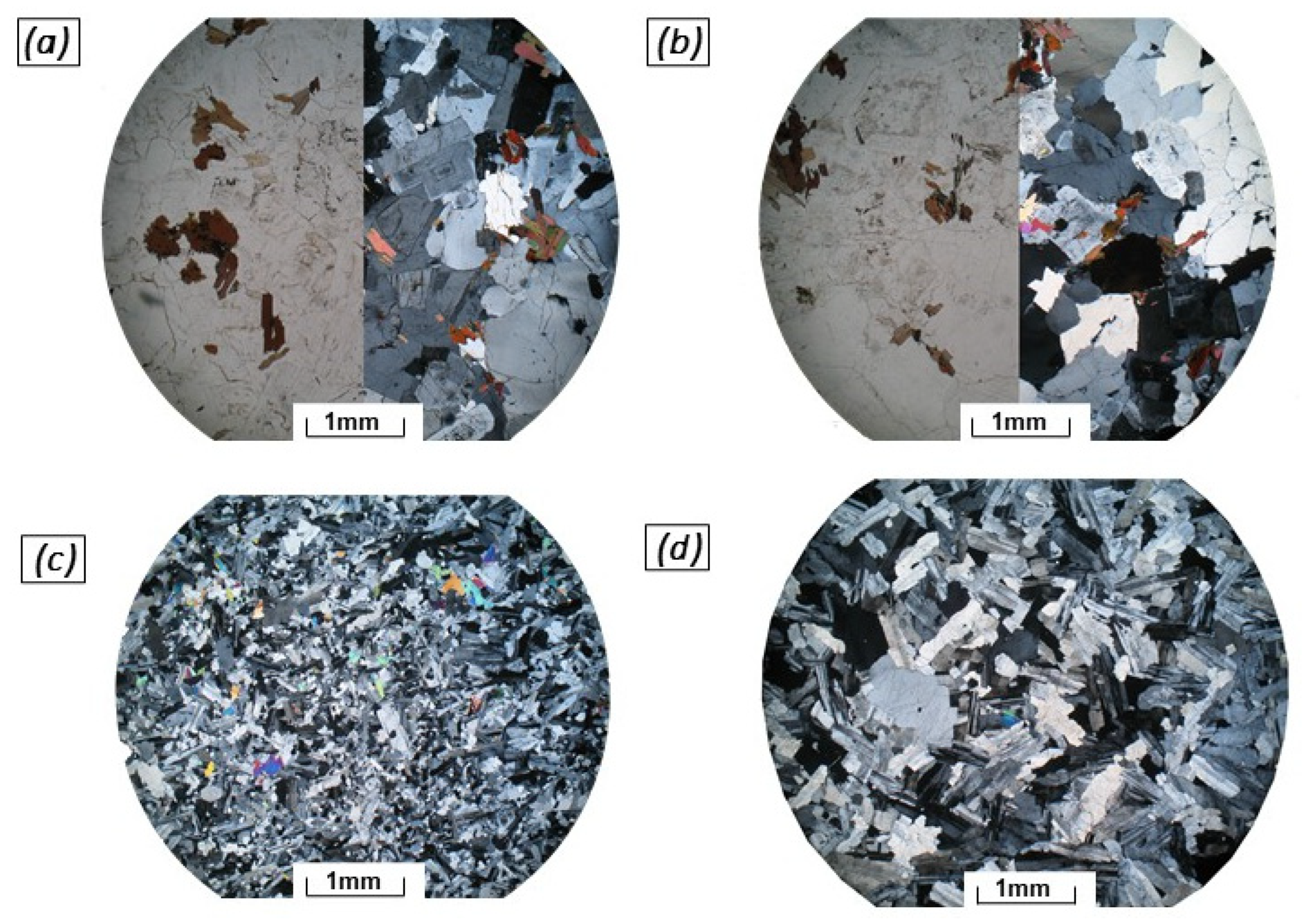
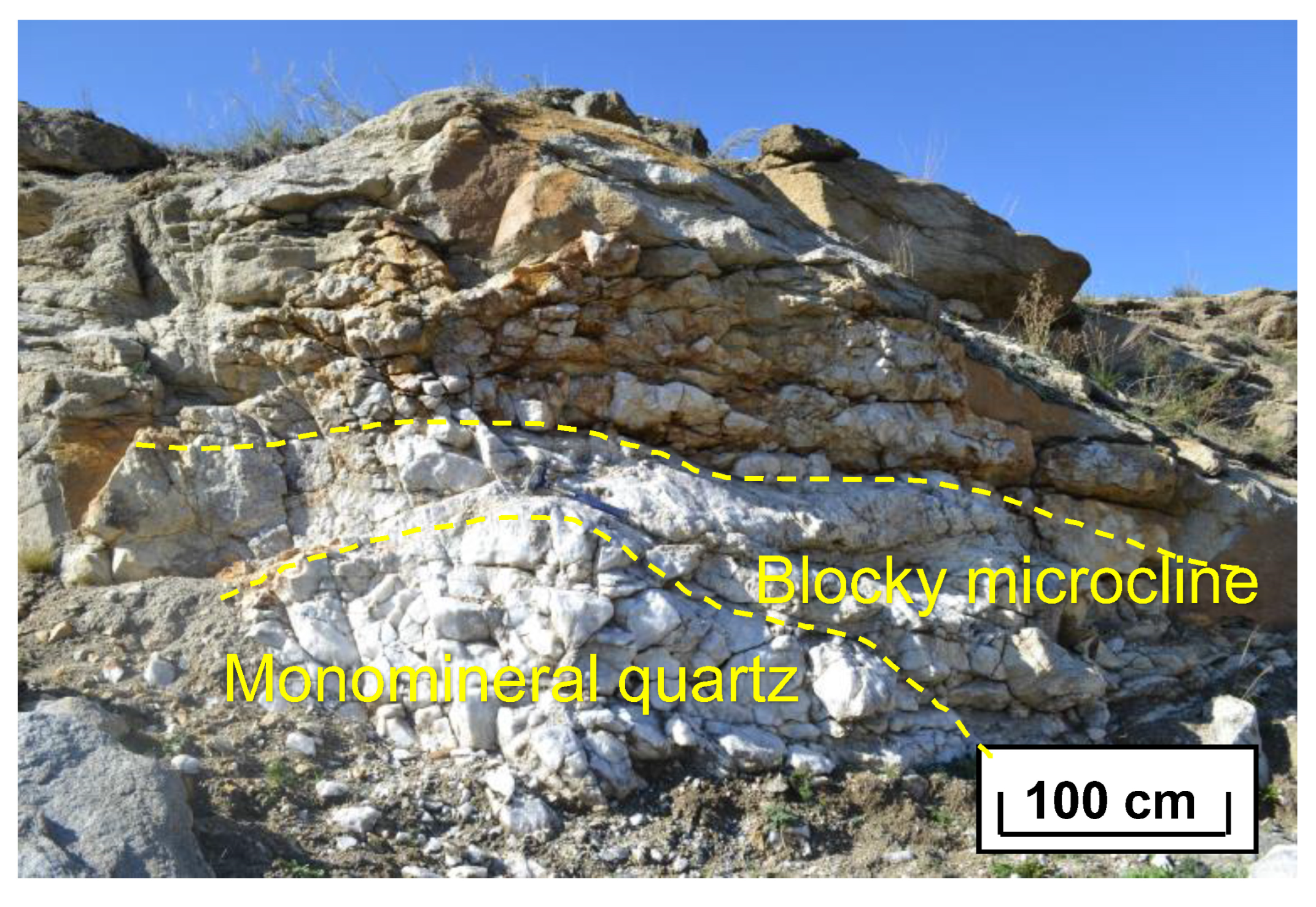

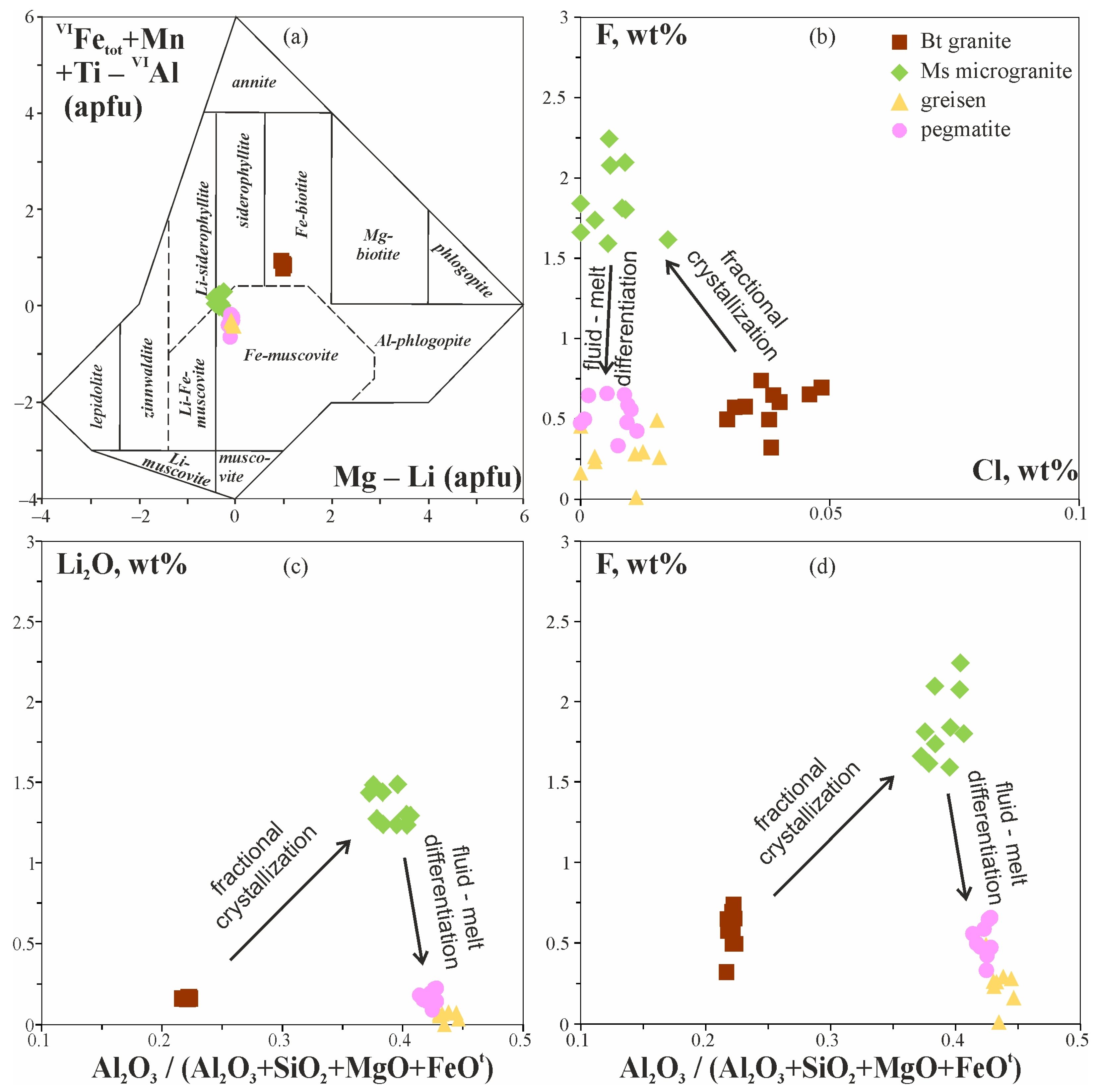

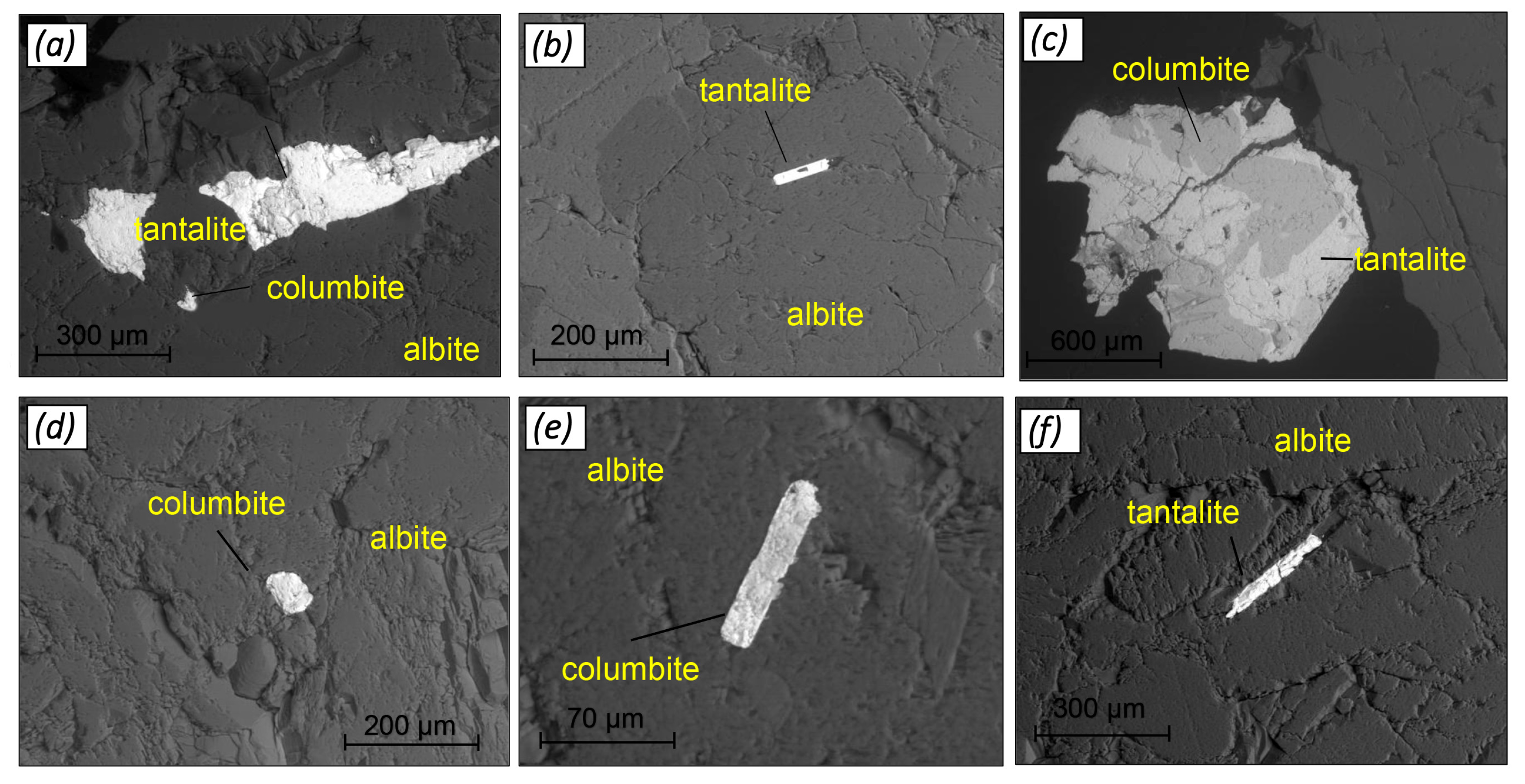
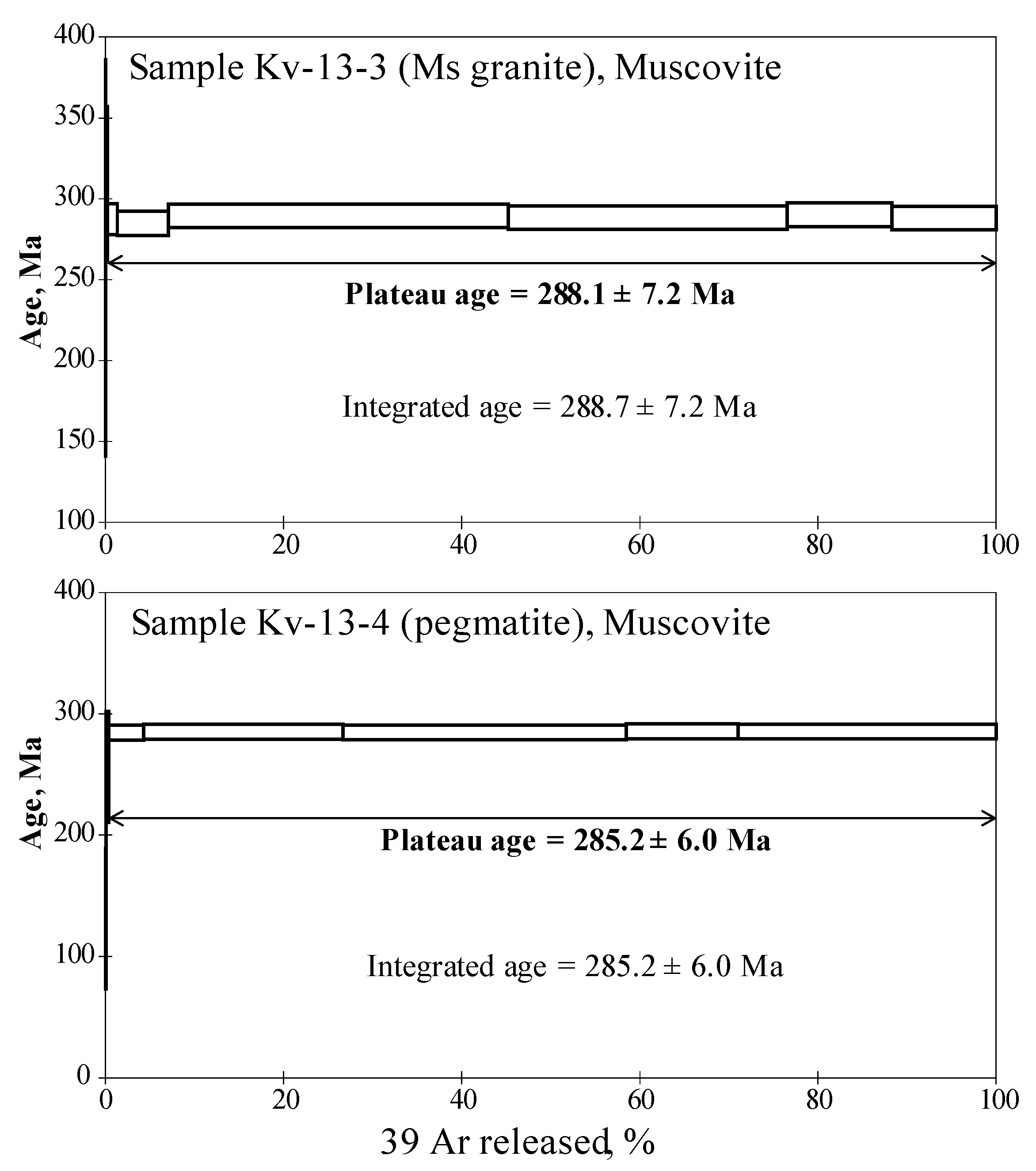
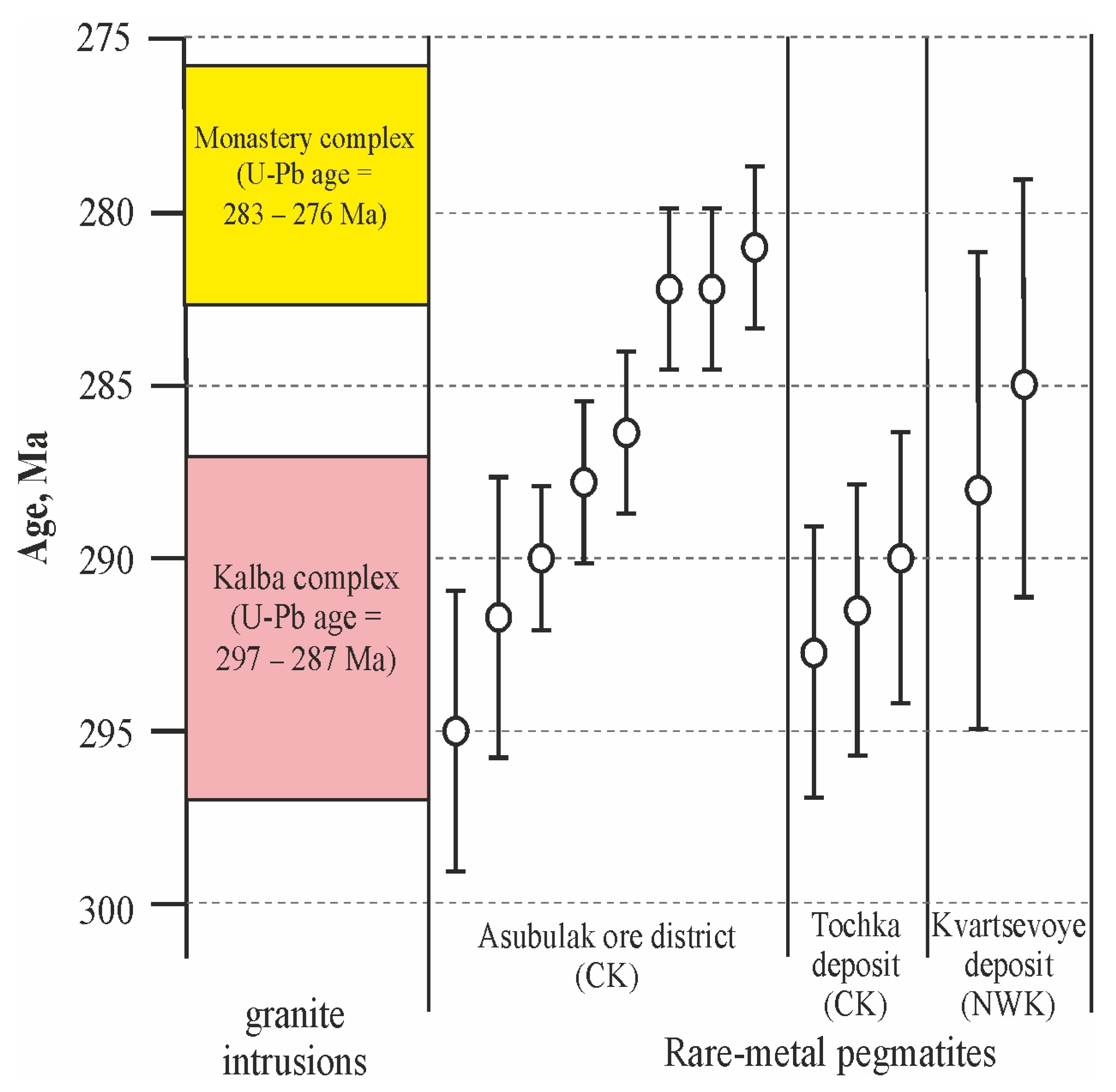
| Rock Type | Component, wt. % | a.p.f.u. | |||||||||||||||||||||||
|---|---|---|---|---|---|---|---|---|---|---|---|---|---|---|---|---|---|---|---|---|---|---|---|---|---|
| SiO2 | TiO2 | Al2O3 | Cr2O3 | FeO | MnO | MgO | Na2O | K2O | Li2O | F | Cl | Sum | TSi | TAl | TFe3+ | MAl | MMg | MFe2+ | MTi | MCr | MMn | MLi | AK | ANa | |
| Bt granite (splAL23-08) | 36.67 | 3.14 | 17.62 | 0.07 | 17.80 | 0.33 | 8.94 | 0.04 | 9.45 | 0.16 | 0.65 | 0.04 | 96.71 | 2.83 | 1.12 | 0.05 | 0.48 | 1.06 | 1.13 | 0.19 | 0.004 | 0.02 | 0.05 | 0.92 | 0.01 |
| 36.66 | 3.12 | 18.06 | 0.05 | 17.94 | 0.32 | 9.02 | 0.16 | 9.37 | 0.16 | 0.60 | 0.04 | 97.30 | 2.82 | 1.15 | 0.04 | 0.49 | 1.06 | 1.12 | 0.18 | 0.003 | 0.02 | 0.05 | 0.91 | 0.02 | |
| 36.53 | 3.32 | 17.63 | 0.06 | 17.90 | 0.31 | 8.89 | 0.10 | 9.58 | 0.16 | 0.58 | 0.03 | 96.88 | 2.82 | 1.13 | 0.04 | 0.47 | 1.05 | 1.14 | 0.20 | 0.004 | 0.02 | 0.05 | 0.93 | 0.02 | |
| 36.46 | 3.22 | 17.95 | 0.06 | 17.51 | 0.34 | 8.60 | 0.02 | 9.41 | 0.17 | 0.65 | 0.05 | 96.17 | 2.83 | 1.14 | 0.04 | 0.50 | 1.03 | 1.14 | 0.19 | 0.004 | 0.02 | 0.05 | 0.92 | 0.00 | |
| 36.40 | 3.58 | 17.78 | 0.06 | 17.46 | 0.31 | 8.58 | 0.11 | 9.48 | 0.17 | 0.57 | 0.03 | 96.25 | 2.83 | 1.15 | 0.02 | 0.48 | 1.03 | 1.14 | 0.21 | 0.003 | 0.02 | 0.05 | 0.93 | 0.02 | |
| 36.45 | 3.25 | 18.10 | 0.07 | 17.59 | 0.34 | 8.86 | 0.09 | 9.46 | 0.16 | 0.50 | 0.04 | 96.64 | 2.81 | 1.16 | 0.03 | 0.49 | 1.05 | 1.12 | 0.19 | 0.004 | 0.02 | 0.05 | 0.92 | 0.01 | |
| 36.64 | 3.10 | 17.96 | 0.06 | 17.79 | 0.34 | 8.96 | 0.05 | 9.54 | 0.16 | 0.69 | 0.05 | 97.12 | 2.82 | 1.14 | 0.04 | 0.49 | 1.06 | 1.13 | 0.18 | 0.004 | 0.02 | 0.05 | 0.93 | 0.01 | |
| 36.34 | 3.25 | 17.48 | 0.06 | 18.09 | 0.34 | 8.86 | 0.07 | 9.46 | 0.16 | 0.32 | 0.04 | 96.30 | 2.82 | 1.12 | 0.06 | 0.48 | 1.06 | 1.12 | 0.19 | 0.004 | 0.02 | 0.05 | 0.93 | 0.01 | |
| 36.43 | 3.02 | 17.96 | 0.07 | 17.72 | 0.36 | 8.96 | 0.10 | 9.49 | 0.16 | 0.50 | 0.03 | 96.56 | 2.81 | 1.15 | 0.04 | 0.48 | 1.06 | 1.12 | 0.18 | 0.004 | 0.02 | 0.05 | 0.93 | 0.01 | |
| 36.03 | 3.14 | 17.80 | 0.06 | 17.58 | 0.36 | 8.73 | 0.10 | 9.56 | 0.17 | 0.74 | 0.04 | 96.09 | 2.81 | 1.16 | 0.03 | 0.48 | 1.06 | 1.15 | 0.19 | 0.004 | 0.02 | 0.05 | 0.94 | 0.01 | |
| Ms mircogranite body (spl K23-01) | 46.79 | 0.52 | 31.75 | 0.01 | 5.34 | 0.41 | 1.38 | 0.16 | 8.31 | 1.43 | 1.66 | 0.00 | 97.10 | 3.25 | 1.30 | 0.00 | 1.30 | 0.00 | 1.20 | 0.06 | 0.001 | 0.02 | 0.40 | 0.74 | 0.02 |
| 46.61 | 0.49 | 32.49 | 0.00 | 5.14 | 0.37 | 1.58 | 0.10 | 8.54 | 1.27 | 1.61 | 0.02 | 97.71 | 3.22 | 1.35 | 0.00 | 1.30 | 0.00 | 1.20 | 0.05 | 0.000 | 0.02 | 0.35 | 0.75 | 0.01 | |
| 46.97 | 0.46 | 32.30 | 0.01 | 5.39 | 0.40 | 1.32 | 0.04 | 8.28 | 1.48 | 1.81 | 0.01 | 97.78 | 3.24 | 1.32 | 0.00 | 1.31 | 0.00 | 1.23 | 0.05 | 0.000 | 0.02 | 0.41 | 0.73 | 0.00 | |
| 46.07 | 0.53 | 32.36 | 0.01 | 4.61 | 0.34 | 1.37 | 0.22 | 8.32 | 1.44 | 2.10 | 0.01 | 96.75 | 3.22 | 1.37 | 0.00 | 1.30 | 0.00 | 1.23 | 0.06 | 0.000 | 0.02 | 0.40 | 0.74 | 0.03 | |
| 46.86 | 0.42 | 33.25 | 0.01 | 4.92 | 0.37 | 1.62 | 0.00 | 8.48 | 1.24 | 1.74 | 0.00 | 98.42 | 3.21 | 1.39 | 0.00 | 1.29 | 0.00 | 1.21 | 0.05 | 0.001 | 0.02 | 0.34 | 0.74 | 0.00 | |
| 46.22 | 0.50 | 34.35 | 0.00 | 4.71 | 0.41 | 1.63 | 0.16 | 8.60 | 1.24 | 1.59 | 0.01 | 98.89 | 3.16 | 1.49 | 0.00 | 1.28 | 0.00 | 1.22 | 0.05 | 0.000 | 0.02 | 0.34 | 0.74 | 0.02 | |
| 43.87 | 0.50 | 34.22 | 0.01 | 5.05 | 0.38 | 1.63 | 0.00 | 8.56 | 1.23 | 2.24 | 0.01 | 97.30 | 3.07 | 1.60 | 0.00 | 1.23 | 0.02 | 1.32 | 0.05 | 0.000 | 0.02 | 0.35 | 0.77 | 0.00 | |
| 43.88 | 0.45 | 34.37 | 0.00 | 4.75 | 0.38 | 1.55 | 0.00 | 8.50 | 1.29 | 1.80 | 0.01 | 96.47 | 3.07 | 1.59 | 0.00 | 1.25 | 0.02 | 1.29 | 0.05 | 0.000 | 0.02 | 0.36 | 0.77 | 0.00 | |
| 44.01 | 0.47 | 34.17 | 0.01 | 5.02 | 0.38 | 1.54 | 0.00 | 8.56 | 1.30 | 2.08 | 0.01 | 97.09 | 3.08 | 1.58 | 0.00 | 1.24 | 0.01 | 1.31 | 0.05 | 0.000 | 0.02 | 0.37 | 0.77 | 0.00 | |
| 44.76 | 0.45 | 33.45 | 0.00 | 4.96 | 0.41 | 1.32 | 0.04 | 8.65 | 1.49 | 1.84 | 0.00 | 96.63 | 3.13 | 1.49 | 0.00 | 1.27 | 0.00 | 1.30 | 0.05 | 0.000 | 0.02 | 0.42 | 0.78 | 0.01 | |
| Greisen (spl AK23-01) | 48.06 | 0.03 | 37.90 | 0.01 | 1.14 | 0.01 | 0.46 | 0.53 | 8.66 | 0.07 | 0.26 | 0.02 | 97.45 | 3.22 | 1.52 | 0.00 | 1.48 | 0.00 | 0.99 | 0.03 | 0.000 | 0.00 | 0.02 | 0.71 | 0.07 |
| 47.20 | 0.03 | 37.77 | 0.01 | 0.97 | 0.03 | 0.26 | 0.45 | 8.80 | 0.08 | 0.29 | 0.01 | 96.12 | 3.20 | 1.54 | 0.00 | 1.47 | 0.00 | 1.02 | 0.03 | 0.000 | 0.00 | 0.02 | 0.74 | 0.06 | |
| 48.29 | 0.09 | 38.15 | 0.03 | 0.93 | 0.05 | 0.40 | 0.61 | 8.77 | 0.00 | 0.01 | 0.01 | 97.56 | 3.23 | 1.53 | 0.00 | 1.48 | 0.00 | 0.96 | 0.03 | 0.001 | 0.00 | 0.00 | 0.71 | 0.08 | |
| 47.98 | 0.05 | 37.47 | 0.00 | 1.17 | 0.04 | 0.44 | 0.46 | 8.62 | 0.07 | 0.26 | 0.00 | 96.72 | 3.23 | 1.51 | 0.00 | 1.47 | 0.00 | 0.99 | 0.03 | 0.000 | 0.00 | 0.02 | 0.72 | 0.06 | |
| 46.98 | 0.06 | 39.11 | 0.02 | 1.04 | 0.01 | 0.47 | 0.45 | 8.34 | 0.04 | 0.16 | 0.00 | 96.99 | 3.15 | 1.65 | 0.00 | 1.44 | 0.00 | 1.01 | 0.03 | 0.001 | 0.00 | 0.01 | 0.69 | 0.06 | |
| 47.67 | 0.03 | 36.72 | 0.02 | 1.64 | 0.07 | 0.42 | 0.40 | 8.21 | 0.14 | 0.45 | 0.00 | 95.87 | 3.23 | 1.48 | 0.00 | 1.46 | 0.00 | 1.00 | 0.03 | 0.001 | 0.00 | 0.04 | 0.70 | 0.05 | |
| 47.72 | 0.06 | 36.43 | 0.00 | 1.08 | 0.03 | 0.58 | 0.32 | 8.12 | 0.15 | 0.49 | 0.02 | 95.06 | 3.25 | 1.45 | 0.00 | 1.47 | 0.00 | 0.97 | 0.04 | 0.000 | 0.00 | 0.04 | 0.69 | 0.04 | |
| 47.27 | 0.05 | 39.21 | 0.02 | 1.25 | 0.08 | 0.45 | 0.44 | 8.58 | 0.07 | 0.28 | 0.01 | 97.85 | 3.15 | 1.65 | 0.00 | 1.44 | 0.00 | 1.03 | 0.03 | 0.001 | 0.00 | 0.02 | 0.70 | 0.06 | |
| 48.57 | 0.04 | 37.94 | 0.01 | 1.31 | 0.04 | 0.26 | 0.61 | 8.56 | 0.06 | 0.23 | 0.00 | 97.82 | 3.24 | 1.51 | 0.00 | 1.48 | 0.00 | 0.98 | 0.03 | 0.001 | 0.00 | 0.02 | 0.70 | 0.08 | |
| Pegmatite of main body (spl Kv23-03) | 47.44 | 0.20 | 37.25 | 0.02 | 2.06 | 0.10 | 0.25 | 0.44 | 9.21 | 0.23 | 0.66 | 0.01 | 98.01 | 3.21 | 1.53 | 0.00 | 1.44 | 0.00 | 1.10 | 0.04 | 0.001 | 0.01 | 0.06 | 0.77 | 0.06 |
| 48.93 | 0.19 | 38.10 | 0.02 | 2.11 | 0.09 | 0.24 | 0.35 | 8.77 | 0.22 | 0.64 | 0.00 | 99.85 | 3.24 | 1.52 | 0.00 | 1.45 | 0.00 | 1.07 | 0.03 | 0.001 | 0.01 | 0.06 | 0.71 | 0.04 | |
| 46.99 | 0.21 | 36.81 | 0.01 | 2.14 | 0.10 | 0.32 | 0.43 | 10.10 | 0.22 | 0.65 | 0.01 | 98.15 | 3.20 | 1.52 | 0.00 | 1.43 | 0.00 | 1.15 | 0.04 | 0.001 | 0.01 | 0.06 | 0.85 | 0.06 | |
| 47.50 | 0.18 | 37.23 | 0.02 | 1.96 | 0.08 | 0.23 | 0.37 | 9.45 | 0.15 | 0.47 | 0.00 | 97.85 | 3.21 | 1.52 | 0.00 | 1.45 | 0.00 | 1.10 | 0.04 | 0.001 | 0.00 | 0.04 | 0.79 | 0.05 | |
| 47.73 | 0.27 | 36.79 | 0.02 | 2.17 | 0.11 | 0.30 | 0.32 | 9.06 | 0.19 | 0.59 | 0.01 | 97.74 | 3.23 | 1.49 | 0.00 | 1.45 | 0.00 | 1.08 | 0.04 | 0.001 | 0.01 | 0.05 | 0.76 | 0.04 | |
| 47.26 | 0.21 | 36.14 | 0.02 | 2.49 | 0.09 | 0.21 | 0.44 | 9.33 | 0.15 | 0.48 | 0.01 | 97.11 | 3.23 | 1.46 | 0.00 | 1.45 | 0.00 | 1.09 | 0.04 | 0.001 | 0.01 | 0.04 | 0.79 | 0.06 | |
| 48.22 | 0.16 | 37.57 | 0.03 | 2.54 | 0.15 | 0.15 | 0.40 | 9.38 | 0.09 | 0.33 | 0.01 | 99.39 | 3.22 | 1.51 | 0.00 | 1.45 | 0.00 | 1.08 | 0.03 | 0.002 | 0.01 | 0.02 | 0.77 | 0.05 | |
| 47.88 | 0.28 | 35.77 | 0.01 | 2.45 | 0.12 | 0.33 | 0.32 | 9.20 | 0.18 | 0.56 | 0.01 | 97.39 | 3.26 | 1.42 | 0.00 | 1.45 | 0.00 | 1.08 | 0.04 | 0.001 | 0.01 | 0.05 | 0.77 | 0.04 | |
| 47.92 | 0.21 | 37.20 | 0.02 | 2.07 | 0.09 | 0.28 | 0.36 | 9.53 | 0.13 | 0.42 | 0.01 | 98.46 | 3.23 | 1.50 | 0.00 | 1.45 | 0.00 | 1.09 | 0.04 | 0.001 | 0.00 | 0.03 | 0.79 | 0.05 | |
| 47.92 | 0.23 | 36.51 | 0.03 | 2.79 | 0.11 | 0.35 | 0.36 | 9.29 | 0.16 | 0.50 | 0.00 | 98.58 | 3.23 | 1.47 | 0.00 | 1.43 | 0.00 | 1.09 | 0.04 | 0.002 | 0.01 | 0.04 | 0.77 | 0.05 | |
| Sample | Ta | Nb | Be | Li | Rb | Cs | Sn | W | Mo | |
|---|---|---|---|---|---|---|---|---|---|---|
| 1 | Kv23-01 | 45.9 | 75.2 | 65.6 | 150.2 | 204 | 25.1 | 38.5 | 1.6 | 6.9 |
| 2 | Kv23-02 | 38.4 | 46.5 | 8.6 | 27.9 | 36 | 6.4 | 25.8 | 1.3 | 7.5 |
| 3 | Kv23-05 | 7.6 | 2.9 | 5.8 | 31.6 | 11 | 1.3 | 4.1 | 1.1 | 6.7 |
| 4 | Q6-24 | 3.3 | 10.1 | 0.6 | 9.0 | 74 | 6.1 | 15.6 | 2.4 | 7.8 |
| 5 | Q5-24 | 5.4 | 52.5 | 3.8 | 8.4 | 47 | 5.7 | 11.8 | 4.2 | 4.6 |
| 6 | Kv23-07 | 5.3 | 7.8 | 10.1 | 243.5 | 167 | 81.8 | 32.7 | 2.4 | 9.3 |
| 7 | Kv23-08 | 3.8 | 7.8 | 3.2 | 170.9 | 89 | 11.2 | 26.3 | 1.8 | 7.6 |
| Sample | Ta | Nb | Be | Li | Rb | Cs | Sn | W | Mo | |
|---|---|---|---|---|---|---|---|---|---|---|
| 1 | Kv23-03 | 28.2 | 47.2 | 37.1 | 274.7 | 487 | 68.8 | 117.0 | 2.9 | 26.7 |
| 2 | Q5-24 | 72.5 | 7.9 | 4.3 | 163.4 | 61.5 | 5.9 | 79.2 | 50.9 | 5.2 |
| 3 | Kv23-04 | 8.3 | 9.9 | 41.7 | 12079 | 53.5 | 12.6 | 79.5 | 1.1 | 16.7 |
| 4 | Q8-24 | 31.1 | 5.4 | 1.2 | 9100 | 53.5 | 6.9 | 57.9 | 66.9 | 5.3 |
| 5 | Kv23-06 | 87.5 | 152.4 | 21.3 | 707 | 1591 | 209.8 | 421.8 | 8.2 | 4.8 |
| 6 | Q5-24M | 59.5 | 90.8 | 6.7 | 452 | 0.1 | 176.7 | 299.1 | 52.9 | 6.2 |
| 7 | Q1-24 | 35.8 | 2.4 | 0.8 | 8.5 | 0.1 | 107.8 | 5.1 | 38.7 | 7.2 |
| 8 | Q2-24 | 34.4 | 4.7 | 255.8 | 51.2 | 0.1 | 37.6 | 19.3 | 41.7 | 7.6 |
Disclaimer/Publisher’s Note: The statements, opinions and data contained in all publications are solely those of the individual author(s) and contributor(s) and not of MDPI and/or the editor(s). MDPI and/or the editor(s) disclaim responsibility for any injury to people or property resulting from any ideas, methods, instructions or products referred to in the content. |
© 2025 by the authors. Licensee MDPI, Basel, Switzerland. This article is an open access article distributed under the terms and conditions of the Creative Commons Attribution (CC BY) license (https://creativecommons.org/licenses/by/4.0/).
Share and Cite
Oitseva, T.A.; Khromykh, S.V.; Naryzhnova, A.V.; Kotler, P.D.; Mizernaya, M.A.; Kuzmina, O.N.; Dremov, A.K. Rare Metal (Li–Ta–Nb) Mineralization and Age of the Kvartsevoye Pegmatite Deposit (Eastern Kazakhstan). Minerals 2025, 15, 737. https://doi.org/10.3390/min15070737
Oitseva TA, Khromykh SV, Naryzhnova AV, Kotler PD, Mizernaya MA, Kuzmina ON, Dremov AK. Rare Metal (Li–Ta–Nb) Mineralization and Age of the Kvartsevoye Pegmatite Deposit (Eastern Kazakhstan). Minerals. 2025; 15(7):737. https://doi.org/10.3390/min15070737
Chicago/Turabian StyleOitseva, Tatyana A., Sergey V. Khromykh, Anna V. Naryzhnova, Pavel D. Kotler, Marina A. Mizernaya, Oxana N. Kuzmina, and Artem K. Dremov. 2025. "Rare Metal (Li–Ta–Nb) Mineralization and Age of the Kvartsevoye Pegmatite Deposit (Eastern Kazakhstan)" Minerals 15, no. 7: 737. https://doi.org/10.3390/min15070737
APA StyleOitseva, T. A., Khromykh, S. V., Naryzhnova, A. V., Kotler, P. D., Mizernaya, M. A., Kuzmina, O. N., & Dremov, A. K. (2025). Rare Metal (Li–Ta–Nb) Mineralization and Age of the Kvartsevoye Pegmatite Deposit (Eastern Kazakhstan). Minerals, 15(7), 737. https://doi.org/10.3390/min15070737








